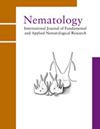New pattern of nematode spermatogenesis revealed by ultrastructural observation of Anaplectus granulosus (Plectidae, Plectida)
IF 1.2
4区 生物学
Q2 ZOOLOGY
引用次数: 0
Abstract
This paper presents the first comprehensive detailed transmission electron microscope observations of sperm development and structure of a plectid nematode. Sperm development of Anaplectus granulosus resembles that of nematodes of the order Rhabditida, known as the rhabditid pattern of spermatogenesis. It includes formation of complexes of fibrous bodies (FB) with membranous organelles (MO), which appear in spermatocytes; the complexes dissociate in the spermatids. The mature spermatozoa are bipolar cells subdivided into a pseudopod and a main cell body containing a nucleus with nine singlet centrioles, peripheral mitochondria and MOs. However, the development and structure of sperm in A. granulosus deviates remarkably from the common rhabditid pattern by an unusual early transformation of FBs into large amorphous masses in the spermatids; the subsequent formation of a concentric structure of immature spermatozoa with a predominant amorphous mass around the central nucleus and thin peripheral cytoplasm with organelles (MOs and mitochondria); and by the transformation of MO in mature spermatozoa into simple cisterns. Thus, the pattern of spermatogenesis of A. granulosus supports the close relations of Plectida and Rhabditida, but specific peculiarities of the sperm development delineate Plectida from Rhabditida and other orders.颗粒无刺线虫超微结构观察揭示线虫精子发生的新模式(Plectidae,Plectida)
本文提出了第一个全面详细的透射电子显微镜观察精子发育和结构的增殖线虫。细粒无鳞线虫的精子发育类似于横纹肌目线虫的精子发育,被称为精子发生的横纹肌模式。它包括纤维体(FB)与膜质细胞器(MO)复合物的形成,这种复合物出现在精母细胞中;复合体在精子中分离。成熟精子是双极细胞,细分为假足和主细胞体,主细胞体含有含有9个单线态中心粒的细胞核、外周线粒体和MOs。然而,A. granulosus精子的发育和结构明显偏离了常见的横纹肌模式,精子中FBs不寻常地早期转化为大的无定形肿块;未成熟精子随后形成同心结构,中心核周围主要有无定形团块,外周细胞质薄,有细胞器(MOs和线粒体);成熟精子中的MO转化为简单的贮池。因此,细粒棘球绦虫的精子发生模式支持Plectida和Rhabditida的密切关系,但精子发育的特定特性将Plectida与Rhabditida和其他目区分开来。
本文章由计算机程序翻译,如有差异,请以英文原文为准。
求助全文
约1分钟内获得全文
求助全文
来源期刊

Nematology
生物-动物学
CiteScore
2.60
自引率
33.30%
发文量
67
审稿时长
3 months
期刊介绍:
Nematology is an international journal for the publication of all aspects of nematological research (with the exception of vertebrate parasitology), from molecular biology to field studies. Papers on nematode parasites of arthropods, and on soil free-living nematodes, and on interactions of these and other organisms, are particularly welcome. Research on fresh water and marine nematodes is also considered when the observations are of more general interest.
Nematology publishes full research papers, short communications, Forum articles (which permit an author to express a view on current or fundamental subjects), perspectives on nematology, and reviews of books and other media.
 求助内容:
求助内容: 应助结果提醒方式:
应助结果提醒方式:


